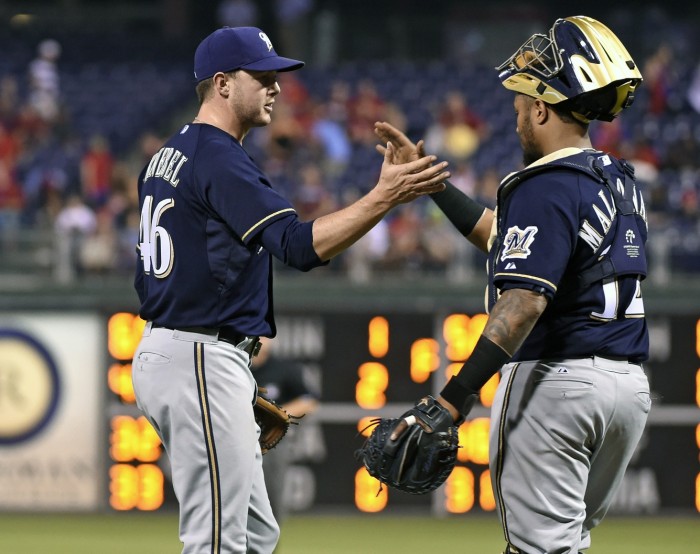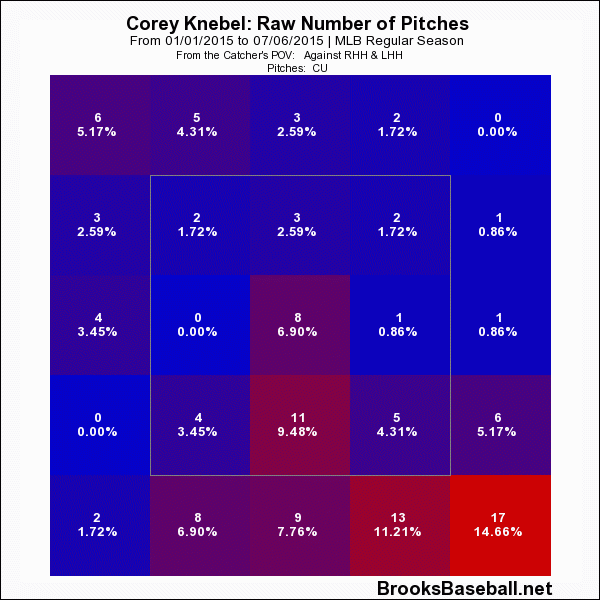The Brewers currently suffer from shortages of many things — dependable starting pitchers, hitters who can take a walk, rangy outfielders — but their bullpen continues to carry them. The club’s relievers have pitched to a 3.58 ERA (14th in the majors) and a 3.66 DRA (fourth in the majors), in an attempt to compensate for the horror show elsewhere on the field.
Obviously, Milwaukee won’t go anywhere this year, meaning this effort doesn’t count for much, but it may impact them next season. As J.P. Breen wrote on Monday, a solid relief core can pay sizable dividends for a team otherwise on the fringes of contention — a place where the Brewers, optimistically, could find themselves in 2016. If the Brewers do find themselves in the hunt once again, players like Francisco Rodriguez, Will Smith, and Michael Blazek could give them an extra boost they’ve lacked in the past.
Then there’s Corey Knebel. Based solely on 2015 results, his name doesn’t stand out from those of Rodriguez, Smith, or Blazek — each of whom owns an ERA and DRA in the low twos. Nevertheless, he’s shown in a couple 2015 stints at the major-league level that he has the capacity to consistently retire hitters. He still has work to do if he wants to become a legitimate set-up man (or even a closer), but the pieces all exist.
Knebel has pitched for two other professional organizations: the Tigers, who drafted him 39th overall in 2013, and the Rangers, who received him in the Joakim Soria deal and sent him away in the Yovani Gallardo swap. His play as a farmhand for both teams in 2014 made quite a bit of noise — enough that BP ranked him fourth in the Brewers’ system. Although an injury scare dampened the enthusiasm surrounding him, it hasn’t noticeably impacted him thus far. Each of his two stretches with the team (one from mid-May to early July, the other from mid-July until now) have had their positive aspects, along with some definitive drawbacks.
The shallowness of his pitch mix sets Knebel apart from many of his compatriots. Only two offerings — a four-seam fastball and a curveball — constitute his repertoire, so they’ll have to excel for him to pitch effectively and consistently. They possess the potential to do so, as the aforementioned scouting report gave them both 6+ grades for the future. They’ve carried steady velocity and movement throughout 2015, and at above-average levels, too:
| Pitch Type | Velocity | MLB Velocity | HMov | MLB HMov | VMov | MLB VMov |
|---|---|---|---|---|---|---|
| Fourseam | 95.9 | 93.1 | -3.0 | -1.7 | 10.0 | 9.1 |
| Curve | 81.9 | 78.7 | 5.1 | 2.9 | -8.6 | -4.5 |
The drop of the curveball, which Knebel has persistently used for about a third of his pitches, stands out in particular. Among 41 relievers who have thrown 100 such pitches, its vertical movement ranks fifth. Because of that drop, the pitch has lived in the lower portion of the zone, especially in the second half of the year:
Hitters haven’t swung at it much, which explains its paltry 58.4 percent overall strike rate. When they have offered at it, though, they’ve missed; its whiff rate has doubled (from 9.5 percent to 18.9 percent) over his two stretches with the team. The frequency of called strikes on the pitch has also come up significantly, to 17.6 percent from 7.8 percent. As BP noted before the season, Knebel “[c]an overthrow the curve, unintentionally burying [it].” Beating this tendency will help the curve to reach its full capability.
Then, of course, there’s the four-seamer. Nothing about its power stands out to the extent that the curveball’s drop does, but it still tops the major-league averages in most regards. It’s thus managed to induce looking and swinging strikes (in addition to strikes in general) at superb clips. In the latter two regards, however, it’s gotten signficantly better as of late:
| Span | Strike% | LookStr% | SwStr% |
|---|---|---|---|
| First Half | 67.9% | 22.2% | 10.7% |
| Second Half | 71.3% | 22.5% | 13.1% |
At first glance, his command seems to have improved. Whereas Knebel struggled to constantly locate the pitch early, he’s executed better by bearing down and in with it:
With that said, hitters have done more damage against the pitch after he came up again. The overall TAv off the four-seamer sits at an unsatisfactory .277, in part because of the five home runs knocked against it. (A sole round-tripper has come off the curveball.) He’s left more pitches around the center of the plate in his second period with the team, for which the opposition has made him pay. BP observed in its scouting report that Knebel’s poor command in the strike zone “could leave [him] susceptible to [the] long ball,” and that’s come true to this point.
Like a lot of young fireballers, Knebel will need to enhance his fastball command and continue refining his breaking ball to make the leap to elite. The stuff is here — these results can testify to that. If he realizes that potential, he’ll join the other established arms in Milwaukee’s bullpen full-time. This may not happen until 2016 or later, a fact that likely doesn’t bother the Brewers. Once this team makes some noise again, Knebel could be there to anchor its late innings.



2 comments on “Corey Knebel Demonstrates His Potential”